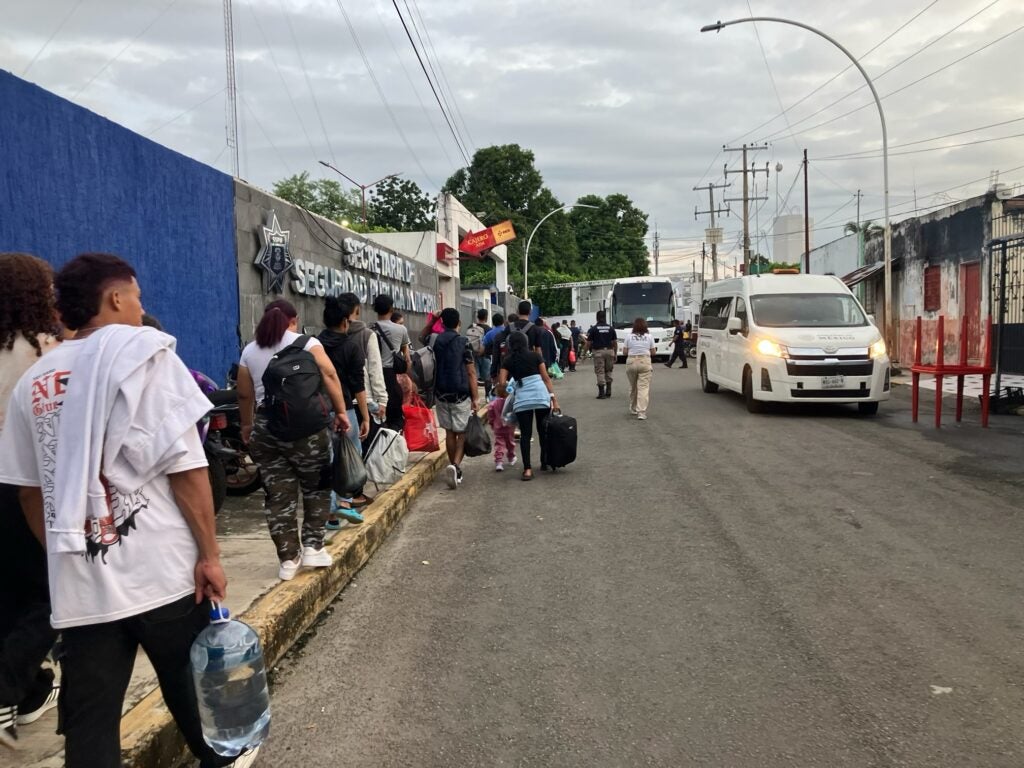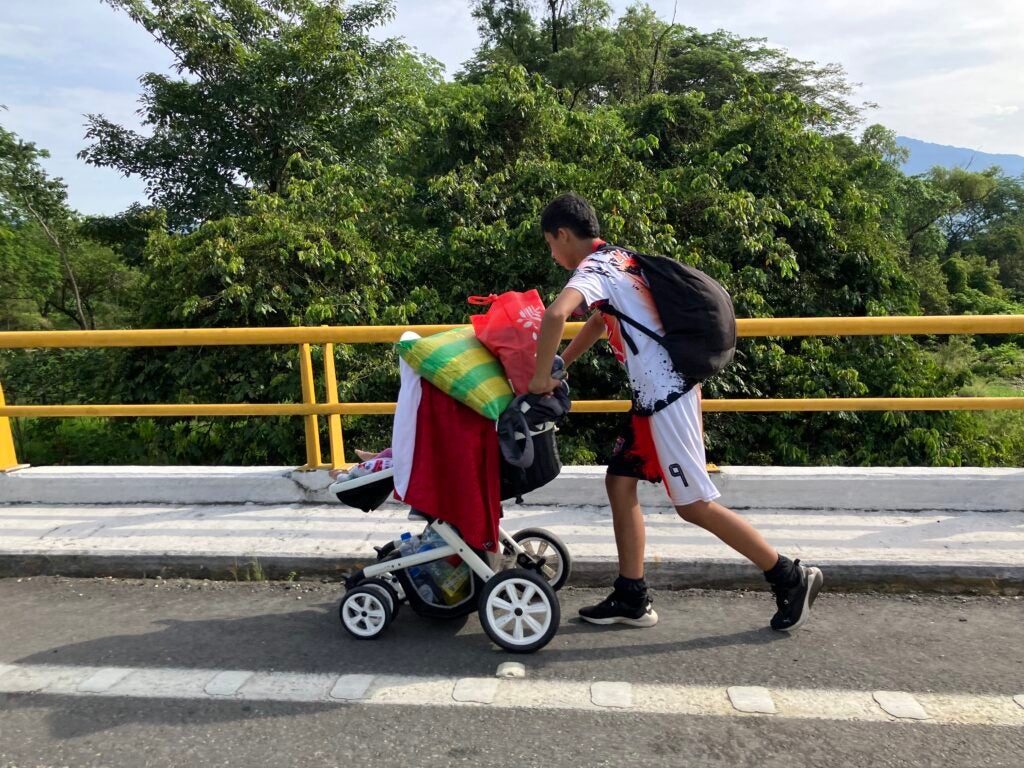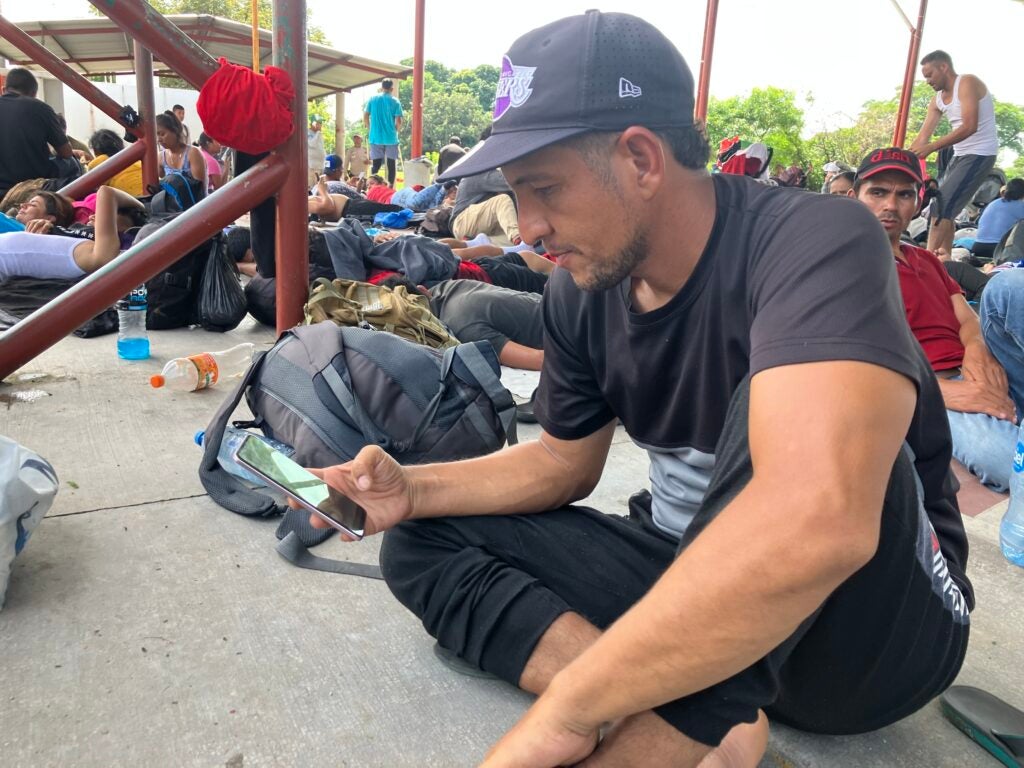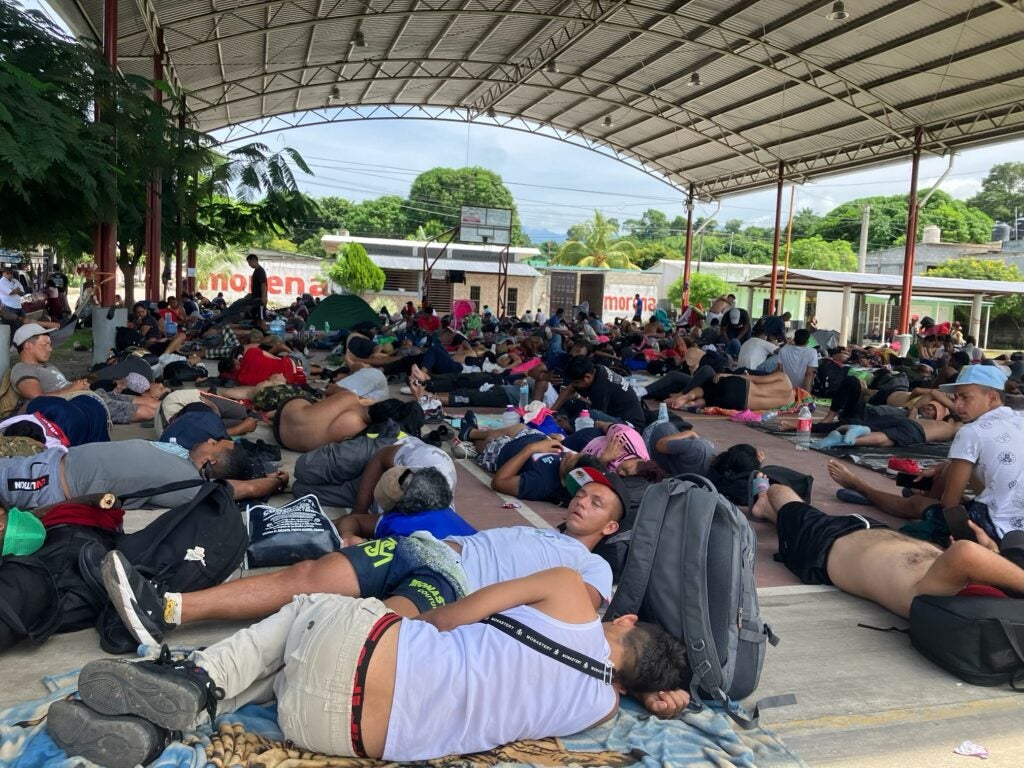
This article was originally published on Daily Signal - Border. You can read the original article HERE
VILLAHERMOSA, Mexico—Jairo Salvador Salinas, a migrant from Honduras, was riding a northbound train toward the Mexico-U.S. border. But Mexican immigration officials detained him at a checkpoint near the city of Monterrey, just 100 miles south of the border. Instead of being deported back to Central America, he was put on a flight to southern Mexico.
“I don’t have any support here,” he said from a shelter for migrants in Villahermosa, a city on the Gulf Coast closer to his native Honduras than the U.S. border.
Migrant encounters at the U.S. southwestern border have fallen precipitously throughout 2024 as migrants like Salinas are increasingly thwarted on their journeys through Mexico.
The question is why.
The White House has credited the decline to restrictions enacted in June on asylum-seekers not making their claims at authorized ports of entry. U.S. Customs and Border Protection reports encounters with migrants slipped to just about 58,000 in August—68% less than the same month in 2023.
But that doesn’t mean the tide has been stemmed. According to Everardo Esquivel, with the nongovernmental International Rescue Committee, they’re still arriving in Mexico.
“Despite reports of decreasing numbers of encounters at the US-Mexico border, thousands of displaced people continue to arrive in Mexico every day,” his agency said in a press release. “For instance, between January and July 2024, over 700,000 people on the move were detained.”
The U.S. election is driving that flow; migrants regularly say they’re concerned that if former President Donald Trump wins, they won’t be allowed into the U.S.
But the situation is even more confusing than that; now, Vice President Kamala Harris has become a newly minted border hawk. Harris has promised even tougher border protections—a sharp turnaround from the Biden administration’s initial attempts at putting a friendly face on U.S. border policy. Trump, her Republican opponent, promises mass deportations if elected on Nov. 5.
But neither the vice president nor the White House put much emphasis on the role Mexico has played as migrant enforcer ahead of the U.S. election: stopping record numbers of migrants heading for the United States and shipping them to its backwater southern states—more than 1,000 miles from the U.S. border.
Mexico registered 712,226 migration apprehensions over the first half of the year, nearly tripling the same period of 2023, according to Mexican immigration officials. The country deports few of the detainees, however. Mexico returned just 11,695 migrants to their countries of origin in the first five months of 2024—compared to nearly 55,000 last year.
Instead, Mexico buses and flies detained migrants to Tabasco and Chiapas states, which border Guatemala. The practice is not new, though it has increased in recent years. Migrants sent south almost inevitably hit the road again, heading northward to the United States, according to priests and migrant shelter operators, only to be returned south in a migrant merry-go-round.
“They effectively have to self-deport,” said Efrain Rodríguez León, director of the nongovernmental Tabasco Human Rights Committee. Past governments would previously deport migrants: mostly Central Americans, who were bused to their countries of origin. “Now they’re detained, and they’re dumped here in Mexico’s southeast. They’re thrown out into the street,” Rodríguez León said, with a document giving them 20 days “to leave the national territory via the southern border and with their own resources.”
No Way Home
For many of the migrants sent south, heading home is unfeasible. That’s largely the product of migrants increasingly coming from South America, the Caribbean, and as far away as Asia and Africa rather than the Northern Triangle of Central America.
Mohammad Dawood, who did not provide his surname, and his family fled Afghanistan after the Taliban returned to power in 2021. They crossed the border to Iran, then headed for Brazil, and headed north through Central America toward the United States.
The family made it to Tijuana but were nabbed by Mexican immigration just a stone’s throw from the border fence. They were subsequently sent to Villahermosa—a sweltering city in the Gulf Coast state of Tabasco, some 2,200 miles from Tijuana—where they didn’t speak the language and were left with few prospects for finding work.
“We have to leave in two days,” he said from Albergue Amparito, a shelter built as a charitable project for the families of patients at a neighboring hospital, but increasingly serving migrants being bused south. “We don’t have anywhere to stay in Villahermosa,” he said via a translation app, adding that no one in his family of five speaks Spanish—save for a teenage daughter who was learning a few words and phrases.
Mexico has said little of its enforcement efforts, though former President Andrés Manuel López Obrador, who left office Sept. 30, insisted that Mexico “cares” for migrants—even as migrants transiting the country are routinely kidnapped, extorted, and trafficked by drug cartels operating in collusion with security and immigration officials. He also bashed Republican governors in 2023 as bad Christians for “not welcoming the stranger” as Texas and Florida passed anti-immigration legislation.
But López Obrador has proved willing to make a lucrative deal on immigration enforcement—after campaigning on the pledge to not do the “dirty work” of foreign governments. He deployed the National Guard to the northern and southern borders in 2019 after Trump threatened Mexico with escalating tariffs on exports if migration didn’t cease. He again deployed the military in 2021 to stop migrants after receiving 2.7 million COVID-19 vaccine doses.
Observers in Mexico see the most recent increased enforcement coinciding with a Dec. 27, 2023, meeting at the National Palace in Mexico City between López Obrador and U.S. officials, led by Secretary of State Antony Blinken.
A joint statement after the meeting offered few details other than the standard talking points of addressing the root causes, combating human smuggling, and promoting orderly migration.
But analysts express few doubts of an understanding being reached, in which the United States stays silent on thorny issues such as rising violence and a controversial overhaul of the country’s courts, in exchange for Mexico’s cooperation.
“This task of pursuing, detaining, and containing migration on the southern border responds precisely to U.S. policy, which wants to avoid mass influxes,” said Father Julio López, a Scalabrinian priest and executive secretary of the Mexican bishops’ conference’s migrant ministry.
Migration Via an App
The migrants sent to southern Mexico are left with few options for heading north again. Mexican officials have established immigration checkpoints on highways the length of the country—especially the south—routinely forcing migrants off buses and the freight trains they steal rides atop. Some migrants hire smugglers out of desperation.
Most, however, turn to the CBP One app. First launched by U.S. Customs and Border Protection in January 2023, the app allows migrants to apply for appointments for entering the United States at an authorized port of entry. Space is limited with just 1,450 appointments allotted daily—and thousands of migrants desperately registering daily.
Until recently, only migrants reaching Mexico City could access the CBP One app. Many migrants preferred to stay put in the capital and try their luck with the app rather than risking the routes north, which are rife with risks such as kidnapping.
They crammed shelters in Mexico City and set up camps in public plazas, but could live relatively safely as they waited for CBP One appointments. They often found work in the country’s vast informal economy to maintain themselves and pay for their eventual trips to the border—with their CBP One appointments accepted for travel by airlines and bus companies.
But some despaired as they waited and headed north without an appointment.
Dawood, the Afghan father, was among them. His family spent four months in Mexico City unsuccessfully trying to snag an appointment through the CBP One app. The family bought plane tickets for Tijuana, wanting to be near the U.S. border. He didn’t say how they were allowed to board a flight without the necessary travel documents. But they were arrested upon arrival in Tijuana and sent south.
“There’s nothing for Afghans here,” said Fatima, Dawood’s 16-year-old daughter. An outgoing teenager with a talent for languages, Fatima passes the time sketching intricate charcoal portraits. She wants to attend classes—something forbidden for girls in Afghanistan—but can’t enroll in Mexican schools.
“I like the U.S.,” she said. “I can go to school there. I can speak English.”
In the meantime, the family continues to apply for appointments through the CBP One app. But most migrants like Dawood and his family will wait months in Mexico’s inhospitable south, where services for migrants are often strained.
“People want to get back to Mexico City and points further north, but the game has totally changed for them,” said Josué Martínez, subdirector of Albergue Amparito. “People are obviously going to get desperate because it’s not like the app gives an appointment in one or two days,” he explained. “More people are going to accumulate here and it’s going to explode.”
Insecurity is also an issue for migrants in southern Mexico as drug cartels dispute crime territories in both Tabasco and Chiapas. The road through Mexico is so insecure that Mexican migration officials charter buses—protected by National Guard escorts—to carry migrants with CBP One appointments to the northern border.
“These CBP measures were supposed to keep migrants from being exposed to organized crime, but it’s counterproductive,” Martínez said. “When they cannot quickly get an appointment, people become desperate, they connect with coyotes, they’re fodder for organized crime.”
Keeping migrants stuck in southern Mexico—and points further south—has been a perpetual U.S. objective. A 2014 scheme increased enforcement known as the Southern Border Plan—which established checkpoints, fixed infrastructure, and prevented migrants from boarding the northbound trains known as La Bestia. It was implemented after thousands of unaccompanied migrant children arrived in the United States but was ultimately abandoned. The Trump administration signed a safe third country agreement with Guatemala—effectively forcing migrants to apply for asylum in the Central American country.
Advocates for migrants in Mexico say expanding the app’s reach to southern Mexico follows the same logic. But it also suits Mexican officials wanting to keep the migrant population in Mexico City in check—despite the capital’s political class proclaiming “progressive” and “humanist” values—according to migrant activists.
“Deep down they didn’t want a migrant population [visible] in the city,” López, the Scalabrinian priest, said of the country’s capital. “The goal is to contain migration down south until they get their appointment.”
In a Migrant Caravan
Migrants have long congregated in Tapachula, the first city they reach after crossing the Suchiate River on rafts from Guatemala.

Migrants have been brought here, as Mexican immigration and security officials established checkpoints along the sweltering coastal highway toward the interior of Mexico and beyond.
But in early October, an estimated 700 migrants grew tired of waiting for the app and formed a caravan with the goal of walking more than 1,000 miles to the U.S. border.

“You need to be lucky” with the app, said Angelo, 25, a construction worker from Peru, as he walked in the early morning to avoid daytime temperatures topping 90 degrees. He spent less than a week in Tapachula but saw an expanding migrant population and fewer and fewer jobs to sustain himself. “I prefer to walk and turn myself in to U.S. authorities,” he said. “I’ve had the American dream since childhood.”
Migrants walking in the caravan expressed misgivings over insecurity in Tapachula—with two saying they were kidnapped upon entering Mexico.
Luis, a 35-year-old Venezuelan in the caravan, says he was “tricked by a kid,” who offered him a motorcycle ride up the road upon entering Mexico. He spent five days in a safehouse until family in Venezuela sent $200 via Western Union. Luis has a screenshot of the receipt. He also has a photo of the stamp on his arm—resembling a fighting cock—that his captors left on his arm, allowing him passage for roughly 20 miles to the border.
“I don’t like Mexico,” he said, adding that if he failed to reach the United States, he would rather head back to Venezuela than stay in Mexico.

Others express an urgency to reach the United States prior to the Jan. 20 change of presidential administrations—amid misgivings over Trump’s plan for mass deportations and rumors of the CBP One app being disbanded.

“We’re fearful that during the elections the president will get rid of humanitarian parole and the CBP One app,” said José, 28, a caravan organizer and Venezuelan migrant. “At that point everything would be up in the air. … We’re trying to move quickly, but it’s hard because we have children, old people, and pregnant women” in the caravan.
José later clarified that he was only worried about Trump, saying of Harris, “The vice president running is already with migrants.”
Edited by Roy Maynard of the Associated News Service.
This article was originally published by Daily Signal - Border. We only curate news from sources that align with the core values of our intended conservative audience. If you like the news you read here we encourage you to utilize the original sources for even more great news and opinions you can trust!










Comments